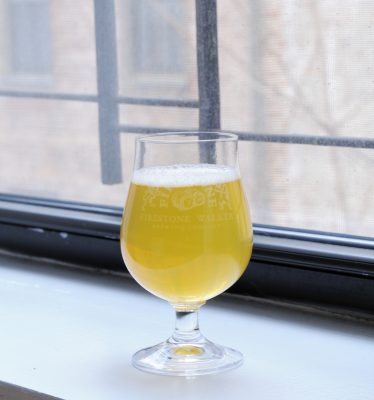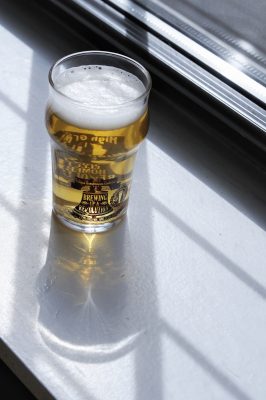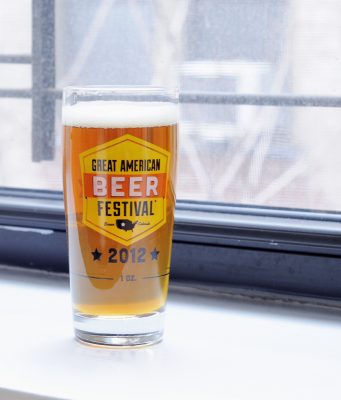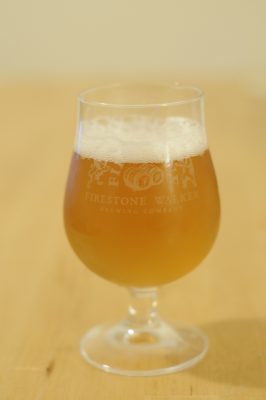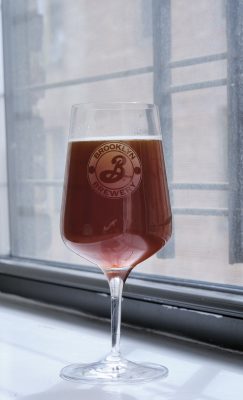One of my all-time favorite flavor combinations in beer is that magical concoction of a lightly sour blond ale and ripe acidic apricot. For me, this is one of the preeminent examples of synergistic beer formulation.
This particular beer starts with a lightly tart base beer provisioned with an ample, earthy Brett funk and naturally occurring stone fruit-like fermentation esters. The sour base reinforces the inherent acidity in the fruit while the slightly phenolic Brett funk finds harmony with the somewhat tannic and earthy qualities that the apricot skins bring to the table. Apricot sour beers can easily become overly acidic (to my palate)/ So with this beer I hoped to start with a mellower sour base beer in order to prevent too much sharp acidity after the fruit had been added and fermented out. If you’re looking for an insanely sour fruit bomb like Cantillon Fou’Foune, you probably don’t want to use this recipe (or, if you do, bump up the fruit addition). If you prefer a mellower, more nuanced beer, then this recipe is on point.
Sour Blond with Apricots Recipe
Specifications:
Size: 3.25 gal
Efficiency: 62% (no sparge)
Attenuation: 83%
Original Gravity: 1.048 (does not consider apricot puree)
Terminal Gravity: 1.008
Color: 4.77 SRM
Alcohol: 5.23% ABV (calculated, does not consider apricot puree)
Bitterness: 0 IBU
Malt Bill:
5.0 lbs. (66.7%) Dingemans Pilsner Malt
1.0 lb. (13.3%) Briess Flaked Wheat
1.0 lb. (13.3%) Briess Flaked Oats
0.5 lb. (6.7%) Weyermann Carafoam
Mash Profile:
158°F – 60m
Water Treatment:
Extremely Soft NYC Water
4 g. Gypsum (to mash)
2 g. Calcium Chloride (to mash)
Hopping:
1 oz. Aged Hops (0.0% AA) – 90m
Kettle Additions:
0.5 ea. Whirlfloc Tablets (Irish moss) – 15m
0.5 tsp. Wyeast Nutrient – 10m
Yeast:
1L – Bioreactor A House Mixed Culture
Secondary Fruit:
3 lbs. 1 oz. – Vintner’s Harvest Apricot Puree. Added after 10 months of primary fermentation. Beer was allowed to referment on the puree for an additional 4 months.
Tasting Notes:
Judged as a BJCP 28C Wild Specialty Beer
Aroma (11/12):
The beer features a complex bouquet of mixed-culture funk. The Brett character is strong with plentiful aromas of wet hay, grass, as well as some fruitier stone fruit elements. There is some acid character on the nose that is tangy and bright. The apricot aroma is somewhat nuanced but well-integrated with the funk, featuring an overripe, fermented fruit character. There is just a touch of grainy malt that sits in the background. I wish the apricot would pop a bit more against the complex fermentation-derived aromatics.
Appearance (1/3):
The beer is a medium golden with a slightly milky haze. Abundant white bubbles form a soapy head when poured, but quickly dissipate.
Flavor (13/20):
Initially the beer showcases a bright, medium-plus lactic sourness. This acidity is complementary to a bright, juicy apricot note that is reminiscent of nicely ripened fresh fruit. The complex Brett funk that was apparent on the nose is pretty subdued on the palate and gives way to the beer’s other fruity elements. The finish is somewhat short, leaving a one note impression of acid and fruit. There is a slight, plastic phenol on the finish.
Mouthfeel (2/5):
The beer is medium-low in body with medium-low carbonation. The beer feels a bit flat and could benefit from a bit more carbonation.
Overall Impression (8/10):
This is a nice, enjoyable fruited sour beer. The fruit melds well with the funky base beer, but would could benefit from a bit more concentration. The sourness in the beer is pleasing and clean without being over-the-top and palate destroying. Nice beer, although it may not stand out in a beer competition due to its more nuanced character.
Very Good (35/50)
Bonus: See how judges scored this beer at the 2017 Homebrew Alley competition in NYC.

